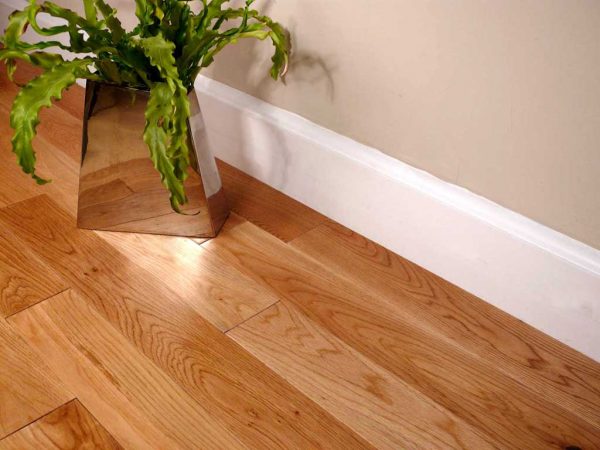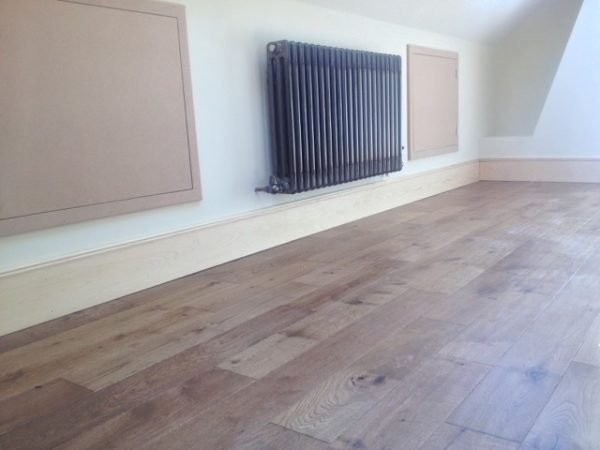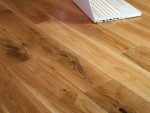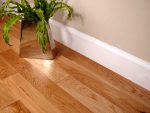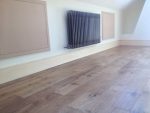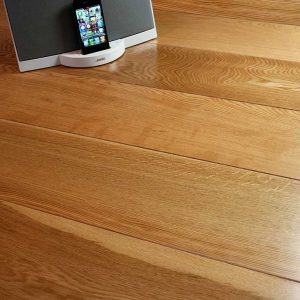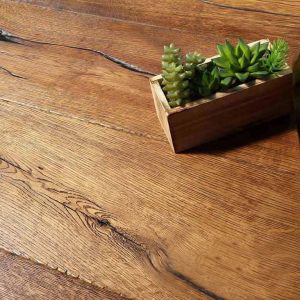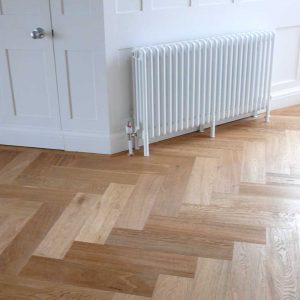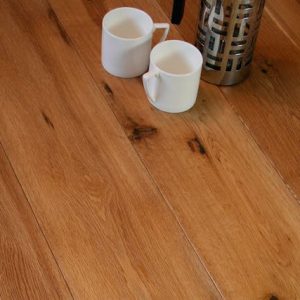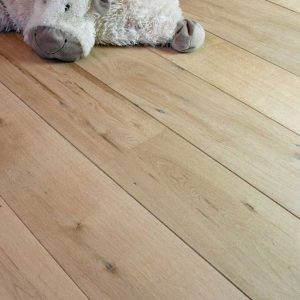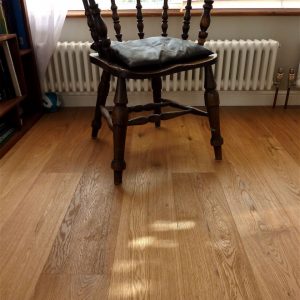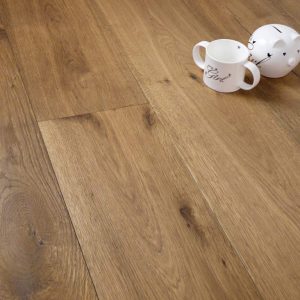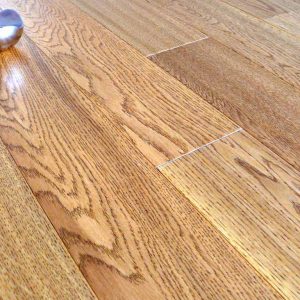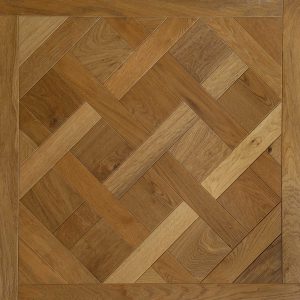Solid Oak
Please see the specification tab below to see our full range of Solid Oak
The main image is of a 120mm wide Lacquered Solid Oak board. Please see our specification tab below for a variety of finishes for solid oak flooring. It also comes in various types of grading please click here for more information about grading and what they are Grading Types.
We also do the same floor finish in the type of Herringbone for the ones who lean into the traditional look and feel of the flooring.
Grades: AB/CD
Style: Plank
Edge: Micro bevelled edges
Register for wood prices
Specifications
| Code | Solid Oak Pre-finished Planks | Grade | Quantity M²/boxes | 1-3 Pallet Price/M² Excluding VAT | |||||||||||||||||||||
|---|---|---|---|---|---|---|---|---|---|---|---|---|---|---|---|---|---|---|---|---|---|---|---|---|---|
| WWF-S9021 | 18 x 90mm x Random Length Solid Lacquered Oak (Short Box) | Classic | 1.08 | £35.99 | |||||||||||||||||||||
| WWF-S1251DIY | 18 x 125mm x Random Length Solid Lacquered Oak (Short Box) | Classic | 1.2 | £36.49 | |||||||||||||||||||||
| WWF-S1258DIY | 18 x 125mm x Random Length Solid Golden Handscraped Oak (Short Box) | Classic | 1.2 | £36.49 | |||||||||||||||||||||
| WWF-S125G | 18 x 125mm x Random Length Solid Golden Handscraped Matt Lacquered Oak (Short Box) | Classic | 1.2 | £36.49 | |||||||||||||||||||||
| WWF-S1501DIY | 18 x 150mm x Random Length Solid Lacquered Oak (Short Box) | Classic | 1.08 | £37.49 | |||||||||||||||||||||
| WWF-S1503DIY | 18 x 150mm x Random Length Solid Brushed & Oiled Oak (Short Box) | Classic | 1.08 | £38.49 | |||||||||||||||||||||
| Code | Solid Oak Pre-finished Blocks | Grade | Quantity M²/boxes | 1-3 Pallet Price/M² Excluding VAT | |||||||||||||||||||||
| WWF-SH184 | 18 x 90mm x 300mm Solid Unfinished Oak Herringbone Blocks | Classic | 1.08 | £33.49 | |||||||||||||||||||||
| WWF-SH185 | 18 x 90mm x 300mm Solid Golden Smoked Brushed UV Oiled Oak Herringbone Blocks | Classic | 1.08 | £35.49 | |||||||||||||||||||||
| WWF-SH186 | 18 x 90mm x 300mm Solid Natural Brushed & Lacquered Oak Herringbone Blocks | Classic | 1.08 | £35.49 | |||||||||||||||||||||
| WWF-SH180 | 18 x 90mm x 300mm Solid Invisible Finish Matt Lacquered Oak Herringbone Blocks | Classic | 1.08 | £35.49 | |||||||||||||||||||||
| Code | FSC European Solid Unfinished Bevelled or Square Shouldered Oak Planks | Grade | Quantity M²/boxes | 1-3 Pallet Price/M² Excluding VAT | |||||||||||||||||||||
| WWF-SB120 | 21 x 120mm x 800-2400mm Solid FSC Euro Unfinished Oak Square Shouldered | Rustic | Variable | £53.49 | |||||||||||||||||||||
| WWF-SB140 | 21 x 140mm x 800-2400mm Solid FSC Euro Unfinished Oak Square Shouldered | Rustic | Variable | £54.49 | |||||||||||||||||||||
| WWF-SB160 | 21 x 160mm x 800-2400mm Solid FSC Euro Unfinished Oak Square Shouldered | Rustic | Variable | £54.49 | |||||||||||||||||||||
| WWF-SB180 | 21 x 180mm x 800-2400mm Solid FSC Euro Unfinished Oak Square Shouldered | Rustic | Variable | £55.99 | |||||||||||||||||||||
| WWF-SB200 | 21 x 200mm x 800-2400mm Solid FSC Euro Unfinished Oak Square Shouldered | Rustic | Variable | £56.49 | |||||||||||||||||||||
| Code | FSC European Solid Unfinished Herringbone Oak Blocks | Grade | Quantity M²/boxes | 1-3 Pallet Price/M² Excluding VAT | |||||||||||||||||||||
| WWF-230R | 21 x 70mm x 230mm Solid FSC European Unfinished Oak Blocks Grooved Both Ends Square Edge | Rustic | 0.644 | £43.49 | |||||||||||||||||||||
| WWF-230P | 21 x 70mm x 230mm Solid FSC European Unfinished Oak Blocks Grooved Both Ends Square Edge | Prime | 0.644 | £48.99 | |||||||||||||||||||||
| WWF-250R | 22 x 70mm x 250mm Solid FSC European Unfinished Oak Blocks Left & Right Handed Square Edge | Rustic | 0.7 | £32.99 | |||||||||||||||||||||
| WWF-250P | 22 x 70mm x 250mm Solid FSC European Unfinished Oak Blocks Left & Right Handed Square Edge | Prime | 0.7 | £38.99 | |||||||||||||||||||||
| WWF-280R | 21 x 70mm x 280mm Solid FSC European Unfinished Oak Blocks Grooved Both Ends Square Edge | Rustic | 0.784 | £38.99 | |||||||||||||||||||||
| WWF-280P | 21 x 70mm x 280mm Solid FSC European Unfinished Oak Blocks Grooved Both Ends Square Edge | Prime | 0.784 | £48.99 | |||||||||||||||||||||
| WWF-300R | 22 x 70mm x 300mm Solid FSC European Unfinished Oak Blocks Left & Right Handed Square Edge | Rustic | 0.84 | £41.49 | |||||||||||||||||||||
| WWF-300P | 22 x 70mm x 300mm Solid FSC European Unfinished Oak Blocks Left & Right Handed Square Edge | Prime | 0.84 | £45.99 | |||||||||||||||||||||
| WWF-350R | 21 x 70mm x 350mm Solid FSC European Unfinished Oak Blocks Grooved Both Ends or Left & Right Square Edge | Rustic | 0.98 | £40.99 | |||||||||||||||||||||
| WWF-350P | 21 x 70mm x 350mm Solid FSC European Unfinished Oak Blocks Grooved Both Ends or Left & Right Square Edge | Prime | 0.98 | £46.99 | |||||||||||||||||||||
Installation
Solid Oak Installation
Always follow the specific manufactures instructions when installing a wood floor. Instructions are usually enclosed within the wood floor packaging.
Solid wood floors can not be used as a floating system and require full fixing to the subfloor. On a wood subfloor we recommend the use of a power nailer or porter nailer. On a concrete subfloor we recommend a flooring adhesive.
When nailing a solid wood floor
1 First make sure the subfloor is in good condition, any loose floor boards should first be secured. If you wish to run the new flooring in the same direction as the original floorboards a 6mm ply board may be required first.
2 Each plank of solid wood flooring should be secretly nailed. Each nail should be fired through the tongue of the board, at least three nails per board or however many is required to secure the board to the subfloor.
Solid wood floors thicker than 18mm can be nailed to a joist or batten as they are classed as a structural board. The board should be nailed evenly to the joist/batten using a secret nailer (port-o-nailer).
We recommend gluing the ends of the boards where they join in case of movement in the floor or joists. The end of the board often sits between the joist but is supported by the rows either side of them.
Concrete subfloors
Solid wood floors need to be fixed to a concrete sub-floor using a wood flooring adhesive. To achieve this the following should be carried out:
1 If building work has included the laying of a new concrete floor, it can take up to a month for each 25mm or 1 inch to dry out enough to safely lay a wood flooring on it. Therefore, if you have a 4 inch screed, it will take 4 months to fully dry out. This can be rectified by the applying a liquid Damp Proof Membrane.
Damp Testing for wood flooring
Many builders test a subfloor for dampness with a prong damp tester. This shows the moisture content of the surface of a concrete floor, however a concrete slab is gives off moisture as the concrete cures for a longer time than most people expect.
The quickest way to check for moisture is to tape a number of clear plastic sheets to the subfloor using duck tape and wait 24 hours. If any of the bags mist up then a proper damp test would be required.
2 Make sure the subfloor is level, any unevenness should be leveled using a recommended screed or leveling compound.
3 A liquid Damp Proof Membrane (DPM) should be applied to the subfloor. Once complete, the flooring can be installed using a recommended adhesive.
Damp Proof Membrane (DPM)
When installing a wooden floor, it is important to protect it against damp and moisture. This can be achieved with a DPM. Solid wood flooring requires a liquid DPM to be applied to the floor. This usually needs two layers, the first painted along the room and the second across the room. The LDPM is available in two colours to help with an even coverage.
Grading
Solid Oak Grading of our Wood flooring
Prime/A.B. Grade Wood Flooring is a mix of A.B grade please see list below
Classic Grade Wood Flooring is mill run grade which is a mix of B.C.D grade with small proportion of A grade.
Country Grade Wood Flooring is a mix of CDE grade
Antique distressed Grade Wood Flooring is a mix of DEF
Grades A-F described
A—without knots and sapwood, uniform colour, sometimes small knots up to max.2mm allowed.
B—with knots up to max.2-4mm, no sapwood, harmonic-natural colour;
C—with knots up to max.6 cm, sapwood max 15%, natural colour;
D—with knots up to 8cm, and max.30% sapwood, allow a wide range of colour variation.
E — with knots up to 10cm, allow cracks up to 30cm in the middle of the boards (max 5mm wide) and end cracks max 25cm (max 8mm wide), allow a wider range of colour variation
F — with crack less than 15-20mm wide in the middle of the boards, longest crack shorter than 80%of the board length
UNDERFLOOR HEATING
Engineered wooden floors can be installed and guaranteed over underfloor heating, however manufactures installation instructions must be followed to validate the guarantee.
We source our wood flooring from a number of different manufactures, therefore each board can have its own warranty which may vary between factories. We will be happy to give advice when choosing the right board for your job.
If you are fitting over underfloor heating, it is important that the engineered wood flooring is fixed tightly -so there are no gaps between the board and the underfloor heating.
If the underfloor heating is laid in a screed, then the wood flooring would be glued to the subfloor using an appropriate flooring adhesive.
A liquid damp proof membrane is always recommended over a new concrete subfloor.
If the underfloor heating is laid in between wooden joists, the product we recommend is a multiply 20 mm thick structural board, fitted using a port-o-nailer to the joists. Where the underfloor heating prevents the nail to go into the joist, a face-fix (tung tight) screw can be used to fix as near to the original fixing place as possible. This gives an even fixing of the wood flooring to the joists across the entire room.
Thinner boards can be laid over underfloor heating. We would recommend a multi-ply board as this can be stuck to the floor using a wood flooring glue or can sometimes be floated using a low tog underlay, depending on the manufactures warranty.
Solid wood floors are not guaranteed over underfloor heating.
Shipping & Delivery
Deliveries
All deliveries are made to the pavement only, the driver is unable to carry goods into the customer’s premises. Please advise us if the delivery address has restricted access or other parking issues.
The driver will unload the goods from the vehicle but it is the customer’s responsibility to ensure sufficient help is available when the delivery arrives.
All goods need to be checked before opening to ensure you have the correct wood that you ordered. We can only accept returns as unopened boxes. Please see our returns policy.
On occasions, the delivery may be made by a courier company, including (depending on the size of the order) a pallet service by a large lorry. You will be informed prior to delivery if this is the case.
Any outstanding balance for goods will be due before delivery, if payment is unable to be made, delivery will need to be arranged.
Deliveries are made between 8 am and 5 pm.
We will endeavor to give a time, however, when using couriers it may just be am or pm.
We make every effort to adhere to an agreed delivery date but can accept no liability for circumstances beyond our control.
Damage; as the delivery is by a third-party delivery company, any damage to the flooring must be pointed out the driver and written on the delivery docket when signing for the delivery, otherwise we can not claim from the courier and we with not be able to recompense you for the damage pack or packs.


